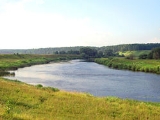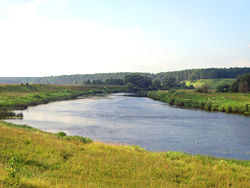
Ugra River
Encyclopedia

Smolensk Oblast
Smolensk Oblast is a federal subject of Russia . Its area is . Population: -Geography:The administrative center of Smolensk Oblast is the city of Smolensk. Other ancient towns include Vyazma and Dorogobuzh....
and Kaluga Oblast
Kaluga Oblast
Kaluga Oblast is a federal subject of Russia . Its administrative center is the city of Kaluga.-Geography:Kaluga Oblast is located in the central part of the East European Plain. The Smolensk Highland lays in the western and north-western part of the oblast, while the Central Russian Highland -...
s in Russia, left tributary of the Oka River
Oka River
Oka is a river in central Russia, the largest right tributary of the Volga. It flows through the regions of Oryol, Tula, Kaluga, Moscow, Ryazan, Vladimir, and Nizhny Novgorod and is navigable over a large part of its total length, as far upstream as to the town of Kaluga. Its length exceeds...
. The east-flowing Ugra joins the north-flowing Oka at Kaluga
Kaluga
Kaluga is a city and the administrative center of Kaluga Oblast, Russia, located on the Oka River southwest of Moscow. Population: It is served by Grabtsevo Airport.-History:...
and the united river, called the Oka, continues east to the Volga. In the 16th century, the Ugra-Oka juncture was the western end of a line of forts protecting Muscovy from Tatar raids. The river is known for the Great stand on the Ugra River. Its length is 399 km and its basin 15,700 square km. It is frozen from late November (sometimes as late as January) until the end of March. 60% of its annual flow is snowmelt, mostly in April.

